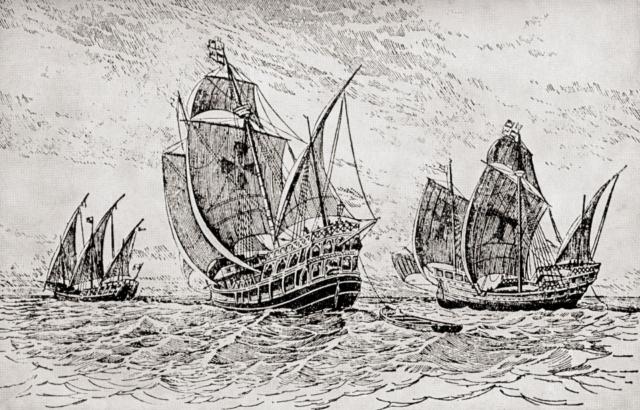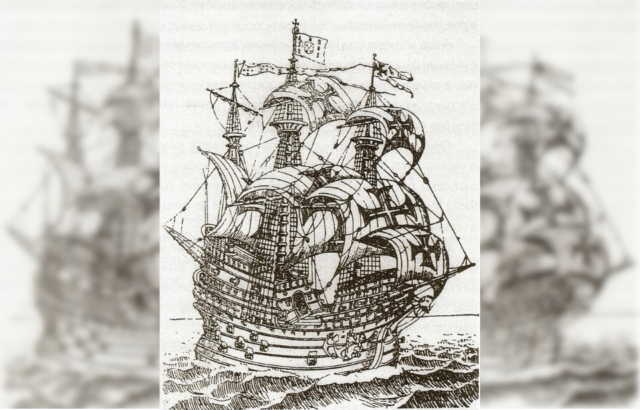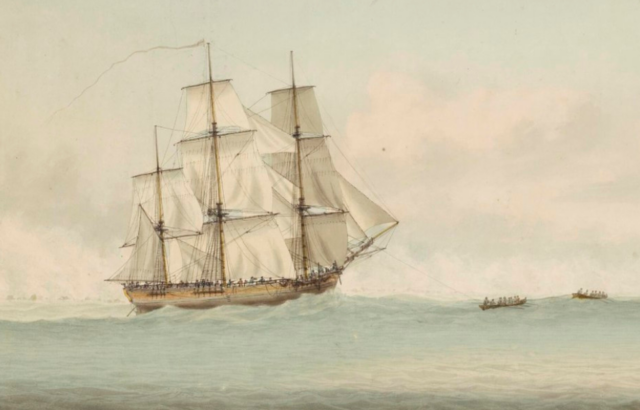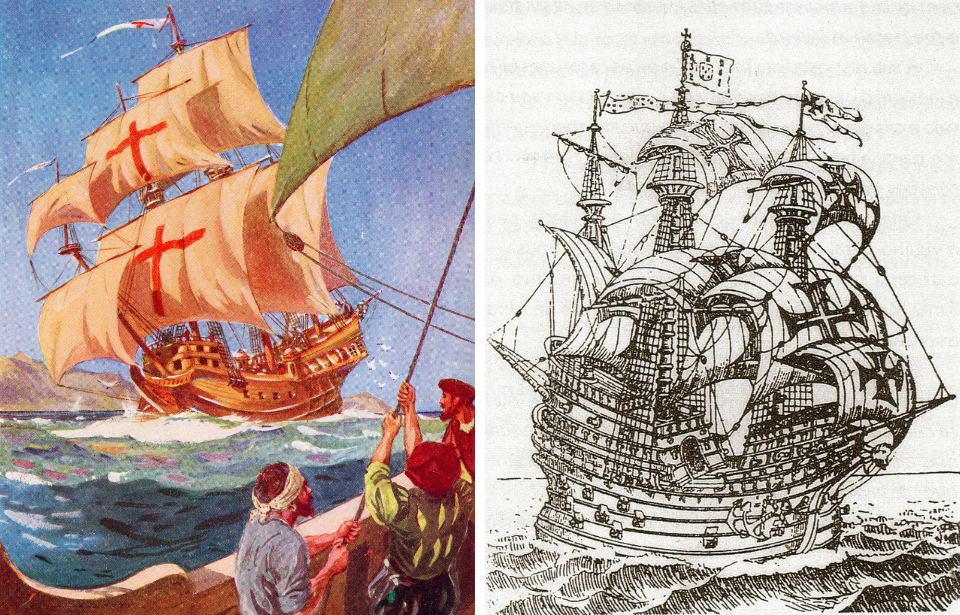The bottom of the sea is littered with shipwrecks. Some of these have captured the public’s imagination because of the ship’s status before it sank and some due to the eventual discovery of the wreckage on the sea floor. Perhaps the most famous is the wreckage of Titanic. Many shipwrecks, however, are never found. Here are four of those famous ships that are still missing beneath the waves. Keep reading to learn more.
Santa Maria
Santa Maria served as Christopher Columbus’ flagship during his historic voyage to the Americas in 1492. On August 3rd, Columbus embarked on his journey from Palos de la Frontera, Spain. Two other vessels accompanied Santa Maria on the expedition, Niña and the Pinta, both smaller caravels.
After a lengthy transatlantic voyage, the expedition made landfall in the Bahamas on October 12, 1492. Columbus mistakenly believed he had reached the eastern shores of Asia, but in reality, he had encountered the islands of the Caribbean. This marked the beginning of sustained contact between Europe and the Americas.

On December 25, 1492, Columbus, after having not slept for two days, decided to lie down. As the night was calm, the steersman also decided to sleep. Before he did so, he left a cabin boy to steer the ship. With the boy at the helm not knowing what to do, the ship ran aground on a reef off the coast of modern-day Haiti.
The fate of Santa Maria was sealed and the ship was deemed beyond repair. Equipment and timbers were removed to establish a fort called La Navidad, north of modern-day Limonade. Stripped of all of her valuables, Santa Maria sank the following day.
The wreckage of Santa Maria remains undiscovered. In 2014, Barry Clifford, a marine archaeologist, claimed to have found the ship. However, UNESCO determined that this wreck actually happened two to three centuries after Santa Maria’s sinking.
Flor de la Mar
Flor de la Mar or Flor do Mar, sometimes spelled Frol de la Mar, meaning Flower of the Sea, was a Portuguese nau that was lost in November 1511. The ship was considered one of the most luxurious and formidable vessels of its time, built to serve as the flagship of the Portuguese fleet during its maritime explorations and trade endeavors in the Indian Ocean.
Constructed in 1502, the Flor de la Mar shortly afterward departed for India under the command of Estevão da Gama, a cousin of Vasco da Gama. The ship’s design was a marvel of naval engineering, boasting a combination of strength and speed. It was heavily armed and equipped to defend itself against pirates and hostile encounters during its voyages.

One of the most notable voyages of the Flor de la Mar was the crucial role she played in the capture of the strategic port of Diu in India in 1509, securing Portuguese dominance in the region and solidifying their control over the spice trade routes.
However, Flor de la Mar’s illustrious history came to a tragic end. In 1511, while returning from Malacca, the ship encountered a fierce storm off the coast of Sumatra. The vessel, laden with riches and heavy cargo, succumbed to the tempestuous seas, sinking along with most of its crew and valuable cargo. The diamonds, gold, and other riches are estimated to be worth up to $2 billion today.
Despite various attempts to locate the wreck, the exact location of the Flor de la Mar’s resting has place remained elusive for centuries and has never been found. Treasure hunter Robert Marx has spent $20 million looking for her,
Royal Merchant
Royal Merchant was a 17th-century English merchant ship. Launched in 1627m she belonged to Captain Limbrey. Between 1637 and 1640, the ship was used for trading with Spanish colonies in the West Indies. On route back to England, Royal Merchant and Dover Merchant, her sister ship, stopped at Cadiz to pick up more cargo.
Signs of a coming disaster became apparent as Royal Merchant started to leak after her voyage across the Atlantic. While in port, a Spanish ship chartered to carry the pay of 30,000 soldiers in Flanders caught fire; Limbrey volunteered Royal Merchant to carry this treasure to Antwerp while en route to England.

The leak continued, and after departing Spain and before reaching London, Royal Merchant sank off the coast of Cornwall. When she sank, the ship had quite a fortune aboard: up to 100,000 pounds of gold, 400 bars of Mexican silver, and up to 500,000 Spanish coins. Today, the treasure that still sits onboard would be worth hundreds of millions of dollars.
In 2007, Odyssey Marine Exploration discovered a wreck. They believed it to be Royal Merchant. However, the coins found with the wreck indicated that they had found a Spanish frigate instead. In 2019, Royal Merchant‘s anchor was found; however, the ship still remains undiscovered.
HMS Endeavour
HMS Endeavour was a British Royal Navy research vessel famously commanded by the skilled navigator and explorer James Cook. The ship played a pivotal role in one of the most significant scientific voyages of the 18th century and is celebrated for its contributions to maritime exploration.
Endeavour was originally built as a collier (a type of coal-carrying merchant ship) in 1764 by Thomas Fishburn, Whitby, England. She was named Earl of Pembroke but was later purchased and converted into a bark and commissioned into the Royal Navy on May 26, 1768, as His Majesty’s Bark Endeavour.
On August 26, 1768, under Captain James Cook’s command, Endeavour set sail from Plymouth. This voyage saw Endeavour sail west to the Pacific, where Cook produced detailed maps and charts of the coastlines of New Zealand. Cook and his crew also spent several months meticulously charting the eastern coastline of Australia, claiming it for Britain and naming it New South Wales.

After completing the successful voyage, Endeavour returned to England in July 1771, concluding a three-year expedition that significantly expanded the known geographical knowledge of the Pacific and its islands.
The ship’s active service didn’t end there, as it served as a troop transport during the American Revolutionary War. Unfortunately, on August 4, 1778, while serving in this capacity, Endeavour, renamed Lord Sandwich, was scuttled off Rhode Island, North America. The decision to sink the vessel was made to prevent the French Navy from accessing Newport Harbor.
More from us: Six of the Most Intriguing Things Ever Found on Shipwrecks
In February 2022, marine researchers claimed to have discovered Endeavour, which the Australian National Maritime Museum corroborated. However, experts say that it is too soon to be absolutely certain.
